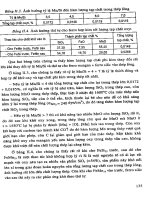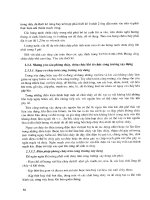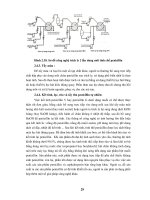Marine Geology Phần 5 ppsx
Bạn đang xem bản rút gọn của tài liệu. Xem và tải ngay bản đầy đủ của tài liệu tại đây (3.51 MB, 34 trang )
The mantle material that slowly extrudes onto the surface is black basalt,
the most common volcanic rock. The ocean floor is paved with abundant
basalt, and most volcanoes are entirely or predominately basaltic.The magma
that forms basalt originates in a zone of partial melting in the upper mantle
more than 60 miles below the surface. The semimolten rock at this depth is
less dense and more buoyant than the surrounding mantle material and rises
slowly toward the surface.
As the magma ascends, the pressure decreases, allowing more mantle
material to melt.Volatiles, such as dissolved water and gases, make the magma
flow easily. The mantle material below spreading ridges that create new
oceanic crust consists mostly of peridotite, which is rich in silicates of iron and
magnesium. As the peridotite melts as it progresses toward the surface, a por-
tion becomes highly fluid basalt.
The magma’s composition indicates its source materials and the depth
within the mantle from which they originated.The degree of partial melting
of mantle rocks, partial crystallization that enriches the melt with silica, and
the assimilation of a variety of crustal rocks influence the composition of the
magma.When the erupting magma rises toward the surface, it incorporates a
variety of rock types along the way, which also changes its composition.The
magma’s composition determines its viscosity and the type of eruption that
occurs.
If the magma is highly fluid and contains little dissolved gas, upon
reaching the surface it produces basaltic lava, and the eruption is usually
mild. If, however, the magma rising toward the surface contains a large
quantity of dissolved gases, the eruption can be highly explosive and quite
destructive. Water is possibly the single most important volatile in magma
and affects the explosive nature of some volcanic eruptions by causing a
rapid expansion of steam as the magma reaches the surface, where it creates
new islands in the sea (Fig. 90).
ISLAND ARCS
Almost all volcanic activity is confined to the margins of lithospheric plates.
Deep trenches at the edges of continents or along volcanic island arcs mark
the seaward boundaries of subduction zones. At convergent plate boundaries,
where one plate subducts under another, new magma forms when the lighter
constituent of the subducted plate melts and rises to the surface. When the
upwelling magma erupts on the ocean floor, it creates island arcs, which occur
mostly in the Pacific.
The longest island arc is the Aleutian Islands, extending more than
3,000 miles from Alaska to Asia, where the Pacific plate ducks beneath the
122
Marine Geology
overriding North American plate. The Kurile Islands to the south form
another long arc. The islands of Japan, the Philippines, Indonesia, New
Hebrides, Tonga, and those from Timor to Sumatra also form island arcs.
These island arcs are all similarly curved, have similar geologic compositions,
and are associated with subduction zones. The curvature of the island arcs
results from the curvature of Earth. Just as an arc forms when a plane cuts a
sphere, so does an arc-shaped feature result when a rigid lithospheric plate
subducts into the spherical mantle.
At deep-sea trenches, created during the subduction process, magma
forms when oceanic crust that is thrust deep into the mantle melts. As the
lithospheric plate carrying the oceanic crust descends farther into Earth’s inte-
rior, it slowly breaks up and melts as well. Over a period of millions of years,
it assimilates into the general circulation of the mantle, possibly descending as
deep as the top of the core. Eventually, the magma rises to the surface in giant
plumes, completing the loop in the convection of the mantle.
The subducted plate becomes the immediate source of molten magma
for volcanic island arcs (Fig. 91). Behind each island arc is a marginal or a
back-arc basin, a depression in the ocean crust due to the effects of plate sub-
duction. Steep subduction zones such as the Mariana Trench in the western
Figure 90 A submarine
eruption of Myojin-sho
Volcano in the Izu
Islands, Japan.
(Photo courtesy USGS)
123
Submarine Volcanoes
Pacific form back-arc basins, whereas shallow ones such as the Chilean Trench
off the west coast of South America do not. A classic back-arc basin is the Sea
of Japan (Fig. 92) between China and the Japanese archipelago, which is a
combination of ruptured continental fragments. Gradually, the sea will close
off entirely as the Japanese islands slam into Asia.
Back-arc basins are regions of high heat flow because they overlie rela-
tively hot material brought up by convection currents behind the island arcs
or by upwelling from deeper regions in the mantle.The trenches are regions
of low heat flow because of the subduction of cool, dense lithospheric plates,
while the adjacent island arcs are generally regions of high heat flow due to
their high degree of volcanism.
GUYOTS AND SEAMOUNTS
Marine volcanoes associated with midocean ridges that rise above the sea
become volcanic islands. Most of the world’s islands began as undersea volca-
noes. Successive volcanic eruptions pile up layers of volcanic rock until the
peak finally breaks through the ocean surface.The volcanic ash also makes a
rich soil. As the island cools, seeds carried by wind, sea, and animals rapidly
turn the newly formed land into a lush tropical paradise. Life must still cope
Figure 91 The
formation of volcanic
island arcs by the
subduction of a
lithospheric plate.
124
Marine Geology
I
s
l
a
n
d
A
r
c
Ocean plate
O
c
e
a
n
p
l
a
t
e
Trench
Ocean plate
Continent
Continent
I
s
l
a
n
d
A
r
c
O
c
e
a
n
p
l
a
t
e
with the rumblings deep within Earth because the island could eventually be
destroyed in a single huge convulsion.
Most volcanic islands end their lives quietly by the incessant pounding
of the sea. Submarine volcanoes called guyots located in the Pacific once tow-
ered above the ocean. However, the constant wave action eroded them below
the sea surface, leaving them as though the tops of the cones had been sawed
off. The farther these volcanoes were conveyed from volcanically active
regions, the older and flatter they became (Fig. 93).This suggests that the guy-
Figure 92 The location
of the Sea of Japan.
125
Submarine Volcanoes
250 Kms
0
250 Miles
0
N
Sado
Shikoku
OSUMI IS.
Honshu
Kyushu
Hokkaido
Tokyo
Nagasaki
Hiroshima
Sea of Japan
Pacific Ocean
East
China
Sea
Sea of
Okhotsk
CHINA
JAPAN
NORTH
KOREA
SOUTH
KOREA
RUSSIA
ots and the plates they rode on wandered across the ocean floor far from their
places of origin.The islands appeared to have formed in assembly line fashion,
each moving in succession away from a magma chamber lying beneath the
ocean floor.
Beyond the oldest Hawaiian island, Kauai, the persistent pounding of the
waves has eroded the volcanoes so that they now lie well below sea level.
Coral living on the flattened tops of eroded volcanoes formed coral atolls,
such as Midway Island, and shallow shoals. Atolls (Fig. 94) are rings of coral
islands enclosing a central lagoon and consist of reefs up to several miles across.
Many atolls formed on ancient volcanic cones that have subsided beneath the
sea, with the rate of coral growth matching the rate of subsidence. Continu-
ing in a northwestward direction is an associated chain of undersea volcanoes
called the Emperor Seamounts (Fig. 95).These were presumably built by a sin-
gle hot spot, although how such a plume could persist for more than 70 mil-
lion years remains unexplained.
Most marine volcanoes never grow tall enough to rise above the sea and
become islands. Instead, most remain as isolated undersea volcanoes called
seamounts. Magma upwelling from the upper mantle at depths of more than
60 miles below the surface concentrates in narrow conduits that lead to the
main feeder column.The magma erupts on the ocean floor, building elevated
volcanic structures that form seamounts. These are generally isolated and
strung out in chains across the interior of a plate. Some seamounts are associ-
ated with extended fissures, along which magma wells up through a main con-
duit, piling successive lava flows on one another. The tallest seamounts rise
Figure 93 Guyots were
once active volcanoes that
moved away from their
magma source and have
since disappeared beneath
the sea.
126
Marine Geology
Volcanic
Island
Subduction
Zone
Erosion
Silt Layer
Continental
Crust
Magma
Plume
Mantle
Oceanic
Crust
Oceanic
Crust
Weak Place
in Crust
more than 2.5 miles above the seafloor in the western Pacific near the Philip-
pine Trench.
More than 10,000 seamounts rise up from the ocean floor. However,
only a few, such as the Hawaiian Islands, manage to break the surface of the
sea.The crust under the Pacific Ocean is more volcanically active than that of
the Atlantic or Indian Oceans, providing a higher density of seamounts. The
number of undersea volcanoes increases with advanced crustal age and
increasing thickness.The average density of Pacific seamounts is 5 to 10 vol-
canoes per 5,000 square miles of ocean floor, by far outnumbering volcanoes
on the continents.
Sometimes the summit of a seamount contains a crater, within which
lava extrudes. If the crater exceeds 1 mile in diameter, it is called a caldera,
whose depth below the crater rim is as much as 1,000 feet. Calderas form
when the magma reservoir empties, creating a hollow chamber.Without sup-
port, the top of the volcanic cone collapses, forming a wide depression simi-
Figure 94 Tarawa and
Abaiang Atolls, Gilbert
Islands.
(Photo courtesy NASA)
127
Submarine Volcanoes
lar to calderas of Hawaiian volcanoes (Fig. 96). Feeder vents along the periph-
ery of the undersea caldera supply fresh lava that fills the caldera, giving the
volcano a flattop appearance. Other undersea volcanoes do not have a col-
lapsed caldera. Instead, the summit contains several isolated volcanic peaks ris-
ing upward of 1,000 feet high.
RIFT VOLCANOES
More than three-quarters of oceanic volcanism occurs at midocean ridges,
where basaltic magma wells up from the mantle and spews out onto the ocean
floor in response to seafloor spreading. Deep-sea ridges called abyssal hills
were developed by eruptions along midocean ridges and cover 60 to 70 per-
Figure 95 The
Emperor Seamounts and
Hawaiian Islands in the
North Pacific represent
motions in the Pacific
plate over a volcanic hot
spot.
128
Marine Geology
800 Kms
0
800 Miles
0
UNITED STATES
(Hawaii)
U.S.
(Alaska)
Russia
H
A
W
A
I
I
A
N
I
S
L
A
N
D
S
E
M
P
E
R
O
R
S
E
A
M
O
U
N
T
S
Midway I.
(U.S.)
Ocean ridges
A
L
E
U
T
I
A
N
I
S
L
A
N
D
S
North Pacific Ocean
Bering
Sea
Gulf of
Alaska
cent of Earth’s surface. Lithospheric plates subduct into the mantle like great
slabs of rock and arise again in giant cylindrical plumes of hot magma at
midocean ridges. A series of plumes miles apart feed separate segments of the
spreading ridge.
At the crest of a midocean ridge, the ocean floor consists almost entirely
of hard volcanic rock. Along much of its length, the ridge system is divided
down the middle by a sharp break or rift that is the center of intense volcanic
activity.The spreading ridges are the sites of frequent earthquakes and volcanic
eruptions, as though the entire system were a series of giant cracks in the crust
from which molten magma oozes out onto the ocean floor.
Volcanic eruptions associated with midocean rift systems are fissure
eruptions, the most common type, and those that build typical conical vol-
canic structures. Fissure eruptions on the ocean floor occur at the boundaries
between lithospheric plates where the brittle crust pulls apart by the process
of seafloor spreading. Volcanoes formed on or near midocean ridges often
develop into isolated peaks when they move away from the ridge axis as the
seafloor spreads apart.
Figure 96 A broad
fountain pit in the cinder
cone and large lava rivers
draining from it,
Halemaumau Volcano,
Hawaiian Islands.
(Photo by G. A.
MacDonald, courtesy
USGS)
129
Submarine Volcanoes
During fissure eruptions, the magma oozes onto the ocean floor as lava
that bleeds through fissures in the trough between ridge crests and along lat-
eral faults. The faults usually occur at the boundary between lithospheric
plates, where the oceanic crust splits apart by the separating plates. Magma
welling up along the entire length of the fissure forms large lava pools, simi-
lar to those of broad shield volcanoes.
The lava formations that erupt on the midocean ridges are sheet flows
and pillow, or tube, flows. Sheet flows are more prevalent in the active volcanic
zone of fast spreading ridge segments, such as those of the East Pacific Rise.
They consist of flat slabs of basalt usually less than 8 inches thick.The lava that
forms sheet flows is much more fluid than that responsible for pillow forma-
tions. Pillow lavas appear as though basalt were squeezed out onto the ocean
floor. They are mostly found in slowly spreading ridges such as the Mid-
Atlantic Ridge, where the lava is much more viscous.The surface of the pil-
lows often has corrugations or small ridges pointing in the direction of flow.
The pillow lavas typically form small, elongated hills descending downslope
from the crest of the ridge.
Seamounts associated with midocean ridges that grow tall enough to
break through the surface of the ocean become volcanic islands.The Galápa-
gos Islands (Fig. 97) west of Ecuador are volcanic islands associated with the
East Pacific Rise.The volcanic islands associated with the Mid-Atlantic Ridge
include Iceland, the Azores, the Canary and Cape Verde Islands off West Africa,
Ascension Island, and Tristan de Cunha.
The volcanic islands in the middle of the North Atlantic that comprise
the Azores were created by a mantle plume or hot spot that once lay beneath
Newfoundland, which then drifted westward as the ocean floor spread apart
at the Mid-Atlantic Ridge.The Sts. Peter and Paul Islands in the mid-Atlantic
north of the equator are not volcanic in origin. Instead, they are fragments of
the upper mantle uplifted near the intersection of the St. Paul transform fault
and the Mid-Atlantic Ridge.
Iceland is a broad volcanic plateau of the Mid-Atlantic Ridge that rose
above the sea about 16 million years ago when the ridge assumed its present
position. It is the most striking example of rift zone hot-spot volcanism.The
magma plume underlying the island extends to the very base of the mantle
some 1,800 miles down.What makes the island unique is that it straddles the
Mid-Atlantic Ridge, where the two plates of the Atlantic basin and adjacent
continents pull apart. Along the ridge, the abnormally elevated topography
extends in either direction about 900 miles, with more than one-third of the
plateau lying above sea level. South of Iceland, the broad plateau tapers off to
form the typical Mid-Atlantic Ridge.
A steep-sided, V-shaped valley runs northward across the entire length
of the island and is one of the few expressions of a midocean rift on land.
130
Marine Geology
Numerous volcanoes flank the rift, making Iceland one of the most volcani-
cally active places on Earth (Fig. 98). The powerful upwelling currents deep
within the mantle produce glacier-covered volcanic peaks up to 1 mile high.
In 1918, an eruption under a glacier unleashed a flood of meltwater 20 times
greater than the flow of the Amazon, the world’s largest river. Iceland experi-
enced another under-ice eruption in 1996, when massive floods from gush-
ing meltwaters and icebergs dashed 20 miles to the seacoast. Icelanders have
known these glacial bursts called jokulhlaups since the 12th century.
On other parts of the midocean ridge, volcanic activity is quite preva-
lent. Perhaps as many as 20 major, deep underwater eruptions occur each year.
Volcanoes formed on or near the midocean ridges often develop into isolated
peaks as they move outward from the ridge axis during seafloor spreading.The
ocean floor thickens as it moves away from the spreading ridge axis. This
thickening of the seafloor influences a volcano’s height because a thicker crust
can support a greater mass.The ocean crust also bends like a rubber mat under
Figure 97 The
Galápagos Islands west of
Ecuador.
131
Submarine Volcanoes
Pacific
Ocean
Wolf
Volcano
Darwin
Volcano
Alcedo
Volcano
Cumbre
Volcano
Cerro Azul
Volcano
0 40 Miles
0
40 Kms
Santo Tomas
Volcano
Mt. Crocker
Mt. San
Joaquín
Mt. Cowan
Isabela
San Salvador
Rabida
Marchena
Pinta
Pinzon
Santa Cruz
Santa Maria
Española
Santa Fe
San Cristóbal
Baltra
Fernandina
VENEZUELA
GALÁPAGOS
ISLANDS
GALÁPAGOS
ISLANDS
(ECUADOR)
Pacific
Ocean
Atlantic
Ocean
SOUTH
AMERICA
the massive weight of a seamount. For instance, the crust beneath Hawaii
bulges in a downward concave shape as much as 6 miles.
A volcano formed at a midocean ridge cannot increase its mass unless it
continues to be supplied with magma after it leaves the vicinity of the ridge.
Sometimes a volcano formed on or near a midocean ridge develops into an
island, only to have its source of magma cut off.Then erosion begins to wear
it down until it finally sinks beneath the sea.
HOT-SPOT VOLCANOES
About 100 small regions of isolated volcanic activity known as hot-spot vol-
canoes exist in various parts of the world (Fig. 99). The hot spots provide a
pipeline for transporting heat from the planet’s core to the surface.The plumes
Figure 98 Seawater is
sprayed onto the lava flow
from the outer harbor of
Vestmannaeyjar, Iceland,
from the May 1973
eruption on Heimaey.
(Photo Courtesy USGS)
132
Marine Geology
do not rise through the mantle as a continuous stream, however.They instead
bubble up as separate giant blobs of hot rock. When the bubbles reach the
ocean floor at the top of the mantle, they create a succession of oceanic
islands.
The ascending mantle plumes can lift an entire region. For example, a
3,000-mile-wide section of the South Pacific floor has risen where several hot
spots have erupted to form the Polynesian Islands. Similar swells occur under
the Hawaiian chain in the North Pacific, Iceland in the North Atlantic, and
the Kerguelen Islands in the southern Indian Ocean.The most active modern
hot spots lie beneath the big island of Hawaii and Réunion Island to the east
of Madagascar.
Unlike most other active volcanoes, those created by hot spots are rarely
situated at plate boundaries. Instead, they reside deep in the interiors of lithos-
pheric plates (Fig. 100). Hot-spot volcanoes are notable for their geologic iso-
lation far from normal centers of volcanic and earthquake activity. Lavas of
hot-spot volcanoes differ markedly from those of subduction zones and rifts.
The distinctive composition of hot-spot magmas suggests that their source is
outside the general circulation of the mantle.
The lavas comprise basalts that contain larger amounts of alkali minerals
such as sodium and potassium, indicating their source material is not con-
nected with plate margins. Instead, the hot spots are supplied from deep
Figure 99 The world’s
hot spots, where mantle
plumes rise to the surface.
133
Submarine Volcanoes
within the mantle, possibly near the top of the core. Hot-spot plumes might
also arise from stagnant regions in the center of convection cells or from
below the region in the mantle stirred by convection currents.
As plumes of mantle material flow upward into the asthenosphere, the
portion rich in volatiles rises toward the surface to feed hot-spot volcanoes.
The plumes exist in a range of sizes that might indicate the depth of their
source material.They are not necessarily continuous flows of mantle material
but might consist of molten rock rising in giant blobs or diapirs. If the
upwelling plumes stopped feeding the asthenosphere with a continuing flow
of mantle material, the plates would grind to a complete halt.
The typical life span of a plume is a few hundred million years. Some-
times a hot spot fades away and a new one forms in its place.The position of
a hot spot changes slightly as it sways in the convective currents of the man-
tle. As a result, the hot-spot tracks on the surface might not always be linear.
Figure 100 The
Brandberg structure in
Namibia near Cape Cross
in Southwest Africa is a
zone of weakness in
Earth’s crust created by
upwelling magma.
(Photo courtesy NASA)
134
Marine Geology
However, compared with the motion of the plates, the mantle plumes are vir-
tually stationary. Because the motion of the hot spots is so slight, they provide
a reference point for determining the direction and rate of plate travel.
The passage of a plate over a hot spot often results in a trail of volcanic
features whose linear trend reveals the direction of plate motion.This produces
volcanic structures aligned in a direction that is oblique to the adjacent mido-
cean ridge system rather than parallel to it as with rift volcanoes.The hot-spot
track might be a continuous volcanic ridge or a chain of volcanic islands and
seamounts that rise high above the surrounding seafloor. The hot-spot track
can also weaken the crust, cutting through the lithosphere like a geologic
blowtorch.
The most prominent and easily recognizable hot spot created the
Hawaiian Islands (Fig. 101), the largest of their kind in the world. The
youngest and most volcanically active island is Hawaii at the southeast end of
the chain. One of the most volcanically active places on Earth is the erupting
Kilauea Volcano on Hawaii (Fig. 102). Every day, several hundred thousand
cubic yards of molten rock gush from a rift zone along its flanks. When the
lava has run its course down the mountainside, it flows into the ocean, adding
acres of new land to the island.The source of these fiery conditions is a man-
tle plume of hot rock burning through the Pacific plate from deep inside
Earth.The hot rock has fueled the five volcanoes that built the Big Island of
Hawaii.
Figure 101 The
Hawaiian Islands formed
by the drifting of the
Pacific plate over a hot
spot.
135
Submarine Volcanoes
Hawaii
HAWAII
Oahu
Kauai
Nihau
Kahoolawe
Maui
Molokai
Lanai
Direction of Plate Movement
MAUNA
LOA
HOT
SPOT
Pacific Ocean
0 100 miles
0 100 kilometers
The oldest volcano, Kohala, on the northernmost part of the island, last
erupted about 60,000 years ago.Today it is worn and eroded, with its north-
eastern flank deeply incised by spectacular valleys and gorges. Just to the south
stands Mauna Kea, which happens to be the tallest mountain on Earth, rising
more than 6 miles from the ocean floor. Southwest of Mauna Kea lies Hualalai
Volcano, which last erupted in 1801 and is still actively, poised for another out-
burst. Southeast of Hualalai is Mauna Loa, the world’s largest shield volcano.
It consists of some 24,000 cubic miles of lava that built up flow upon flow
into a huge, gently sloping mound, making it the most voluminous mountain
on Earth. The youngest volcano, Kilauea, emerges from the side of Mauna
Loa. Lava has erupted continuously since the early 1980s from a rift zone on
Kilauea, which over time could greatly outgrow its host volcano.
Some 20 miles south of Hawaii is a submerged volcano called Loihi,
which rises about 8,000 feet above the ocean floor but is still 3,000 feet
below the sea surface. Perhaps in another 50,000 years it will rise above sea
and take its place as the newest member of the Hawaiian chain. The rest of
the Hawaiian Islands are progressively older, with extinct volcanoes trailing
off to the northwest.
The entire Hawaiian chain apparently formed from a source of magma
from the deepest part of the mantle over which the Pacific plate has passed in
a northwesterly direction. The volcanic islands slowly popped out onto the
ocean floor conveyor-belt fashion, with the oldest trailing off to the northwest
farthest away from the hot spot. Similar chains of volcanic islands lie in the
Figure 102 A lava flow
entering the sea from the
March 28, 1955,
eruption of Kilauea
Volcano, Hawaii.
(Photo by G. A.
MacDonald, courtesy
USGS)
136
Marine Geology
Pacific and trend in the same general southeast-to-northwest direction as the
Hawaiian Islands (Fig. 103).This indicates that the Pacific plate is moving off
in the direction defined by the line of volcanoes. Lying parallel to the Hawai-
ian Islands are the Austral and Tuamotu ridges.The islands and seamounts were
formed by the northwestward motion of the Pacific plate over a volcanic hot
spot.
The plate did not always travel in this direction, however. Some 43 mil-
lion years ago, it turned and followed a more northerly heading. The course
change possibly resulted from a collision between the Indian and Asian plates
and appears as a distinct bend in the hot-spot tracks. A sharp bend in the long
Mendocino Fracture Zone jutting out of northern California confirms that the
Pacific plate abruptly changed direction at the same time as the India-Asia plate
Figure 103 The
linearity of volcanic
islands on the Pacific plate
in the direction of
movement.
137
Submarine Volcanoes
LO
UI
SVI
L
LE RIDGE
C
A
RO
LI
NE IS
.
M
A
R
S
H
A
L
L
-
G
I
L
B
E
R
T
I
S
.
A
U
S
T
R
A
L
R
I
D
G
E
T
U
AMOTU I
S
.
EMPEROR RISE
H
A
W
A
I
I
A
N
I
S
LINE IS.
San Francisco
(Wake Island)
NORTH
AMERICA
Callao
SOUTH
AMERICA
N
1,200 Kms
0
1,200 Miles
0
Equator
North Pacific Ocean
South Pacific Ocean
PHILIPPINE IS.
JAPAN
ASIA
NEW
ZEALAND
NORTH
AMERICA
AUSTRALIA
Volcanic chains
convergence. The timing is also coincident with the collision of the North
American and Pacific plates. From these observations, geologists conclude that
hot spots are generally a reliable means for determining plate activity.
The Bermuda Rise in the western Atlantic appears to contradict this rule.
It is oriented in a roughly northeast direction, parallel to the continental margin
off the eastern United States.The Bermuda Rise is nearly 1,000 miles long and
rises some 3,000 feet above the surrounding seafloor. The last of its volcanoes
ceased erupting about 25 million years ago. A weak hot spot unable to burn a
hole through the North American plate was apparently forced to take advantage
of previous structures on the ocean floor acting as conduits, which explains why
the volcanoes trend nearly at right angles to the motion of the plate.
The Bowie seamount is the youngest in a line of submerged volcanoes
running toward the northwest off the west coast of Canada. A mantle plume
feeds it more than 400 miles below the ocean floor and is nearly 100 miles in
diameter. Rather than lying directly beneath the seamount, as plumes usually
do, this one lies about 100 miles east of the volcano.The plume might have
taken a tilted path upward, or the seamount might have somehow moved with
respect to the hot spot’s position.
If a midocean ridge passes over a hot spot, the plume augments the flow
of molten rock welling up from the asthenosphere to form new crust.The crust
is therefore thicker over the hot spot than along the rest of the ridge, resulting
in a plateau rising above the surrounding seafloor. The Ninetyeast Ridge,
named for its location at 90 degrees east longitude, is a succession of volcanic
outcrops that runs 3,000 miles south of the Bay of Bengal. It formed when the
Indian plate passed over a hot spot on its way to Asia about 120 million years
ago, creating an immense lava field on India known as the Rajmahal Traps.
The movement of the continents was more rapid than today, with per-
haps the most vigorous plate tectonics the world has ever known.This activ-
ity resulted in many flood basalt eruptions (Fig. 104). About 120 million years
ago, an extraordinary burst of submarine volcanism struck the Pacific basin,
releasing vast amounts of lava onto the ocean floor.The volcanic spasm is evi-
denced by a collection of massive undersea lava plateaus that formed almost
simultaneously. The largest of these plateaus is the Ontong Java, northeast of
Australia. At roughly two-thirds the size of the Australian continent, it con-
tains at least 9 million cubic miles of basalt, enough to bury the entire United
States under 15 feet of lava.
About 65 million years ago, a giant rift opened up along the west side
of India. Huge volumes of molten lava poured onto the surface, forming the
Deccan Traps flood basalts. The rift separated the Seychelles Bank from the
mainland, leaving behind the Seychelles Islands. They were followed 40 mil-
lion years ago by the Kerguelen Islands as India continued to trek northward
toward southern Asia.
138
Marine Geology
The Kerguelen plateau is the world’s largest submerged platform.
Approximately 50 million years ago, a huge submerged plateau in the Indian
Ocean separated into two platforms that now sit about 1,200 miles apart.The
plateau grew from the ocean floor more than 90 million years ago when a
series of volcanic eruptions poured out voluminous amounts of molten basalt
onto the Antarctic plate as the continent separated from Australia.
During the next several million years, a long rift sliced through the plate
and cut off its northern section, which latched onto the Indian plate and
started on a long journey northward. Meanwhile, the southern half of the
plate continued to move southward. Half of the original platform, called
the Broken Ridge, currently lies off the west coast of Australia.The other half,
the Kerguelen plateau, sits north of Antarctica.The Exmouth plateau is a sub-
merged feature that sits on a sunken piece of the Australian continent, which
itself was attached to India when all continents were assembled into Pangaea.
VOLCANIC ACTIVITY
Volcanoes take many shapes and sizes, depending on the composition of the
erupted magma.The four main types of volcanoes are cinder cones, composite
volcanoes, shield volcanoes, and lava domes. Cinder cones are the simplest vol-
canic structures.They are built from particles and congealed lava ejected from a
single vent.The 100-mile-long St. Lawrence Island in the North Bering Sea was
built up by a number of cinder cones (Fig. 105). Explosive eruptions form short,
steep slopes usually less than 1,000 feet high. Cinder cones build upward and
Figure 104 Areas of
major flood basalt
volcanism.
139
Submarine Volcanoes
outward by accumulating layers of pumice, ash, and other volcanic debris falling
back onto the volcano’s flanks.The general order of events is eruption, followed
by formation of cone and crater, and then lava flow.
Composite volcanoes are constructed from cinder and lava cemented
into tall mountains rising several thousand feet.They are generally steep sided
and comprise symmetrical lava flows, volcanic ash, cinders, and blocks. The
crater at the summit contains a central vent or a cluster of vents. During erup-
tion, the hardened plug in the volcano’s throat breaks apart by the buildup of
pressure from trapped gases below. The pent-up pressures shoot molten rock
and fragments high into the air.
The fragments then fall back onto the volcano’s flanks as cinder and ash.
Layers of lava from milder eruptions reinforce the fragments, forming cones
with a steep summit and steeply sloping flanks. Lava also flows through breaks
in the crater wall or from fissures on the flanks of the cone, continually build-
ing it upward. As a result, composite volcanoes are the tallest cones in the
world and often end in catastrophic collapse, thus preventing them from
becoming the highest mountains.
Figure 105 St.
Lawrence Island in the
Bering Sea, showing
cinder cones at the
northwest end of
Kookooligit Mountains.
(Photo by H. B. Allen,
courtsey USGS)
140
Marine Geology
Shield volcanoes produce the broadest and largest cones.The slope along
their flanks generally rises only a few degrees and no more than 10 degrees
near the summit.They erupt almost entirely basaltic lava from a central vent.
Highly fluid molten rock oozes from the vent or violently squirts out, form-
ing fiery fountains of lava (Fig. 106).
As the lava builds in the center, it flows outward in all directions, form-
ing a structure similar to an inverted dinner plate. The lava spreads out and
Figure 106 A high
lava fountain from an
eruption of Kilauea,
Hawaii.
(Photo by D. H. Richter,
courtesy USGS)
141
Submarine Volcanoes
covers large areas, as much as 1,000 square miles. If the lava is too viscous or
heavy to flow very far, causing it to pile up around the vent, it forms a lava
dome, which grows by expansion from within. Lava domes commonly occur
in a piggyback fashion within the craters of large composite volcanoes.
Volcanoes erupt a variety of rock types.These range from rhyolite with
a high silica content to basalt with a low silica and high iron-magnesium con-
tent. Basalt is the heaviest volcanic rock and the most common igneous rock
type produced by the extrusion of magma onto the surface. Pumice is the
lightest volcanic rock and can actually float on water. For instance, during the
August 27, 1883, eruption of Krakatoa, floating pumice several feet thick
posed a hazard to shipping in the area.
Tephra, from the Greek, meaning “ash,” includes all solid particles ejected
into the atmosphere from volcanic eruptions.Tephra includes an assortment of
fragments from large blocks to dust-sized material. It originates from molten
rock containing dissolved gases that rises through a conduit and suddenly sep-
arates into liquid and bubbles when nearing the surface. As the pressure
decreases, the bubbles grow larger. If this event occurs near the orifice, a mass
of froth spills out and flows down the sides of the volcano, forming pumice.
If the reaction occurs deep down in the throat, the bubbles expand explosively
and burst the surrounding liquid, which fractures the magma into fragments.
The fragments are then driven upward by the force of the rapid expansion and
hurled high above the volcano.
Cinder and ash supported by hot gases originating from a lateral blast of
volcanic material is called nuée ardente, French for “glowing cloud.”The cloud
of ash and pyroclastics flows streamlike near the ground and might follow exist-
ing river valleys for tens of miles at speeds upward of 100 miles per hour.The
best-known example was the 1902 eruption of Mt. Pelée, Martinique. It pro-
duced a 100-mile-per-hour ash flow that within minutes killed 30,000 people
at Saint-Pierre.When the tephra cools and solidifies, it forms deposits called ash-
flow tuffs that can cover an area up to 1,000 square miles or more.
Lava is molten magma that reaches the throat of a volcano or fissure vent
and flows freely onto the surface.The magma that produces lava is much less
viscous than that which produces tephra. This allows volatiles and gases to
escape with comparative ease and thus gives rise to much quieter and milder
eruptions. The outpourings of lava have Hawaiian names, Aa (pronounced,
AH-ah), which is the sound of pain when walking over them barefooted, is
blocky lava that forms when viscous, subfluid lavas press forward, carrying
along a thick and brittle crust.As the lava flows, it stresses the overriding crust,
breaking it into rough, jagged blocks.These are pushed ahead of, or dragged
along with, the flow in a disorganized mass.
Pahoehoe, (pronounced pah-HOE-ay-hoe-ay), which means satinlike,
are ropy lavas (Fig. 107) that are highly fluid basalt flows produced when the
142
Marine Geology
Figure 107 Ropy lava
surface of pahoehoe near
Surprise Cave, the
Craters of the Moon
National Monument,
Idaho.
(Photo by H.T. Stearns,
courtesy USGS)
143
Submarine Volcanoes
surface of the flow congeals, forming a thin, plastic skin. The melt beneath
continues to flow, molding and remolding the skin into billowing or ropy-
looking surfaces. When the lavas eventually solidify, the skin retains the
appearance of the flow pressures exerted on it from below. If a stream of lava
forms a crust and hardens on the surface and the underlying magma contin-
ues to flow away, it creates a long cavern or tunnel called a lava tube. Long
caverns beneath the surface of a lava flow are created by the withdrawal of lava
as the surface hardens. In exceptional cases, they can extend up to several miles
within a lava flow.
The output of lava and pyroclastics for a single volcanic eruption varies
from a few cubic yards to as much as 5 cubic miles. Rift volcanoes generate
about 2.5 billion cubic yards per year, mainly submarine flows of basalt. Sub-
duction zone volcanoes produce about 1 billion cubic yards of pyroclastic vol-
canic material per year.Volcanoes over hot spots produce about 500 million
cubic yards per year, mostly pyroclastics and lava flows on the continents and
basalt flows in the oceans.
After discussing marine volcanism, the next chapter explains the role
ocean currents play on Earth.
144
Marine Geology
T
his chapter examines ocean currents, tides, and waves. The ocean is
constantly in motion, distributing water and heat to all corners of the
globe (Fig. 108). In effect, the ocean acts as a huge circulating machine
that makes Earth’s climate equitable. Ocean currents follow well-defined
courses. The ocean transports tremendous quantities of seawater, serving as a
global conveyor belt over the planet.Abyssal storms stir the deep-ocean floor,
shifting sediments on the seabed.
El Niño currents, caused by a great sloshing of seawater in the Pacific
basin, generate unusual weather patterns throughout the world.Waves and tides
are constantly changing and rearranging the shoreline. Tsunamis produced by
undersea earthquakes and coastal volcanic eruptions are among the most
destructive waves, inflicting death and destruction to many seacoast inhabitants.
RIVERS IN THE ABYSS
Currents in the upper regions of the ocean (Fig. 109) are driven by the winds,
which impart their momentum to the ocean’s surface. The currents do not
145
Abyssal Currents
Ocean Circulation
6
flow in the wind direction. Instead, they are deflected by the Coriolis effect
(Fig. 110) to the right, or northwest, in the Northern Hemisphere and to the
left, or southwest, in the Southern Hemisphere.This is because a point on the
surface moves faster at the equator than if it were near the poles because it is
farther away from the axis of rotation and must travel a greater distance over
time. Currents moving toward the poles experience the surface slowing down,
which deflects them to the east. Currents moving toward the equator experi-
ence the surface speeding up, which deflects them toward the west.
The currents acquire warm water from the tropics and distribute it to
the higher latitudes. They then return to the tropics with cold water. This
exchange moderates the temperatures of coastal regions, making countries
such as Japan and northern Europe warmer than they otherwise would be for
their latitudes. The Gulf Stream snakes 13,000 miles clockwise around the
North Atlantic basin, transporting warm tropical water to the northern
regions.
The North Atlantic acts as a tremendous heat pump that periodically
warms and cools the atmosphere over the course of decades, sometimes rein-
forcing and sometimes counteracting greenhouse warming. The counterpart
of the Gulf Stream in the North Pacific is another strong flow called the Japan
current. This current bears warm water from the tropics, sweeps northward
against Japan, crosses the upper Pacific, and turns southward to warm the west-
ern coast of North America. The major current in the South Pacific is the
Figure 108 Heat flow
between the ocean and
atmosphere is responsible
for distributing the ocean’s
heat around the world.
146
Marine Geology
Evaporation
Radiation
Conduction
Precipitation
Ocean current









![[Đồ Án Điện Tử] Thiết Kế Máy Phát 3 Pha - Bộ Ổn Dòng phần 5 ppsx](https://media.store123doc.com/images/document/2014_07/14/medium_wlu1405275643.jpg)